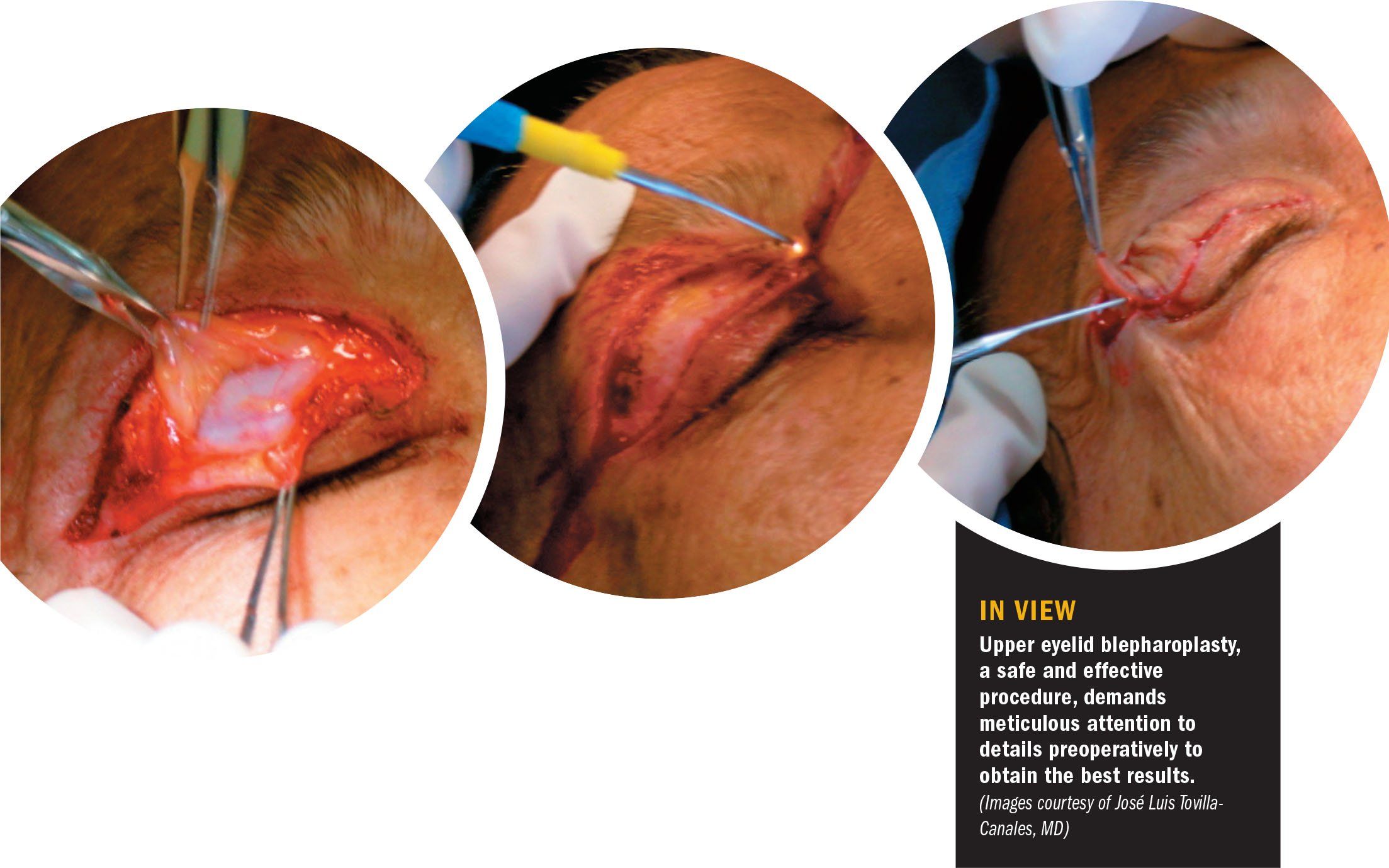Article
Pearls for upper eye lid blepharoplasty
Author(s):
No cookie-cutter procedure, UEB can improve patients’ visual fields by more than 25%

Reviewed by José Luis Tovilla-Canales, MD
Upper eyelid blepharoplasty (UEB) is the most frequently performed invasive facial esthetic procedure, according to José Luis Tovilla-Canales, MD. The procedure can remove excess skin, muscle and sometimes fat from the upper or lower eyelids. It is performed for either functional or cosmetic indications. UEB may be performed in a traditional fashion, using stainless steel instruments, or may be modified with radiosurgery incisional techniques or laser incisional techniques.
Following UEB, the visual fields can improve by as much as 26.2%. Dr. Tovilla-Canales, director, Orbit and Oculoplastics Department, Instituto de Oftalmologia, Mexico City, Mexico, enumerated his pearls for performing a successful UEB. “The surgery is usually considered a simple procedure, but there are key points that must be adhered to before surgery to avoid adverse events,” he said. Dr. Tovilla-Canales offered several key points to consider for successful UEB procedures:
- The procedure is not a recipe. Each patient will have different anatomic landmarks, and, therefore, have different surgical needs.
- The brows and the different amounts of skin to be excised must be considered.
- Understand the anatomy. Knowledge of the anatomy is essential to perform an appropriate technique for each patient.
- The preoperative assessment is one of the most important steps before surgery is even undertaken. The physician must obtain a history and perform a complete examination, discuss expectations with the patient, select the appropriate technique, and discuss potential complications.
- Patients must be instructed to stop taking aspirin and anticoagulants before surgery.
- Physicians also should obtain preoperative photographs in the event that patients question the postoperative outcome.
Another consideration in the preoperative assessment is determining whether just skin or skin and fat are to be removed.
“Watch the eyebrow,” Dr. Tovilla-Canales said, pointing out that the eyebrows are always considerations when performing UEB. He demonstrated cases with the preoperative presence of upper lid ptosis, a droopy eyebrow, fat pads in the lateral aspect upper lids disguised as upper lid ptosis and bulging of the upper lids caused by supraobicularis fat, indicating that these must be addressed to achieve an appropriate UEB.
Perhaps the most important surgical factor is marking the incisions, according to Dr. Tovilla-Canales.
“With the patient supine, I create the crease in the patient’s natural crease, usually 10 millimeters from the lid margin in women and a little lower in men,” he explained, demonstrating the pinch test, performed using forceps with the patient sitting and with eyes closed, to determine the amount of skin to remove.
Dr. Tovilla-Canales said he uses a guideline of 20 millimeters from below the incision to above the incision as a safe amount. When it comes to anesthesia, Dr. Tovilla-Canales advises administering intravenous sedation preoperatively and a small amount of local anesthesia.
The incision, skin and fat removal also are important, and Dr. Tovilla-Canales said his preference is to create incisions using a blade rather than a CO2 laser because of the possibility of wound dehiscence related to the laser. Once the incision is created, Dr. Tovilla-Canales performs electrocautery. When removing the orbicularis, he said he prefers to remove only skin and preserve as much orbicularis as possible.
When removing fat, he extracts the least amount possible to avoid hollowing of the eye. Typically, he removes only the medial fat pad. Dr. Tovilla-Canales also emphasized the importance of identifying lacrimal gland prolapse, which also can mimic the appearance of fat pads; his procedure of choice in such cases is to reposition the lacrimal gland with sutures.
The procedure is not simply one of removing skin and/or fat, but recognition of structural issues such as ptosis. “Surgeons must be very conservative with the amount of skin, fat, and orbicularis muscle that is left postoperatively,” he said.
During wound closure and crease formation, the wounds can be closed with interrupted 6-0 or 7-0 nylon or Prolene sutures. In some cases, a crease may need to be created. Dr. Tovilla-Canales said he takes a small bite of the orbicularis muscles, a bite of the aponeurosis where it joins the tarsus and finally another bite of the orbicularis muscle in the upper incision.
While UEB appears to be a simple procedure, complications can occur. This can include asymmetry, ptosis, lagophthalmos, ocular motility disorders, scarring, hematoma, retrobulbar hemorrhage, and lymphedema.
“UEB is usually a safe and effective procedure,” Dr. Tovilla-Canales concluded. “Complications can be prevented by performing an adequate preoperative assessment, understanding the patient’s expectations, obtaining meticulous measurements for skin markings, and proper surgical technique.”
Disclosures:
JoÅe Tovilla-Canales, MD
E: jltovilla@yahoo.com
Dr. Tovilla-Canales has no financial interest in any aspect of this report.
Newsletter
Don’t miss out—get Ophthalmology Times updates on the latest clinical advancements and expert interviews, straight to your inbox.




